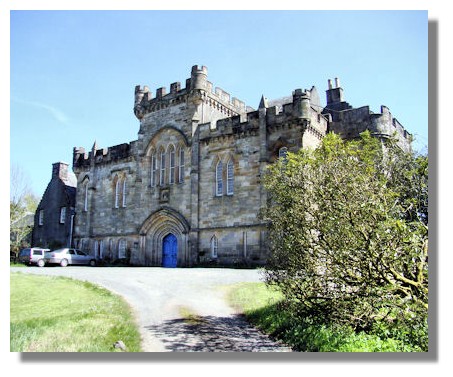
Scottish Castles Photo Library
- Craufurdland Castle

The name Craufurd (there are many variant spellings (such as Crawford, Crayford) may have been derived from Strathclyde Gaelic for "crossing of blood". Within the estate there was once a fortress on the right bank of the upper River Clyde where no doubt there would be many bloodthirsty conflicts.
The earliest official reference to the Crawford surname is in 1127 when two knights of this name served under King David I (1124-1153), Sir John (Johannes) and Sir Gregan de Crawford. In 1127 Sir Gregan was involved in the legendary incident when King David was saved from a stag (and thereafter founded the Abbey of Holyrood as a result). As oldest son, John received his father's lands in the upper Strathclyde. It is from this John who died in 1140 that the parish received the name Crawfordjohn. Sir Reginald (sometimes called Ranald or Ronald) de Crawford (1180-1250) from Crawfordjohn was appointed heritable Sheriff of Ayr by William the Lion who reigned from 1165-1214. About 1200 Reginald married Margaret de Loudoun, the heiress of that extensive barony. The second Sheriff of Ayr was Hugh, the oldest son of the first Sheriff.
John, the 3rd son of Sir Reginald de Crawford the first Sheriff of Ayr is however the ancestor of the Clan branch at Craufurdland in Ayrshire. He was married to Alicia de Dallsalloch and through this marriage large tracks of lands in Clydesdale came into the ownership of the family. But much of this passed to the Cumins on marriage of his daughter. The lands of Ardoch, however, were given to John Craufurd, the second son of John and Alicia He lived in the reign of Alexander II (1214-1249)
James Craufurd of Craufurdland was a follower of Sir William Wallace, his cousin and the immortal hero of Scotland. The Crawfords risked life and property providing protection for William Wallace. It is suggested that during this time Wallace's Crawford uncles were influential in training him in the arts of diplomacy, war, and languages as well as encouraging Wallace's desire to re-establish an independent Scotland.
Wallace's younger brother John and uncle Sir Reginald Crawford, both of whom were prominent in the service of both Wallace and Robert the Bruce, were executed at Carlisle in 1307 for their loyalty to Wallace.
The castle of the Boyd's, Dean Castle, was located in Kilmarnock, some 2 miles from Craufurdland. Legend has it that the two castles were connected by an underground passage. When the soldiers of Edward I of England lay siege around Dean Castle for three months the English soldiers were starting to starve and the residents within Dean Castle hung out fresh beef supplied by the tunnel and offered it to the starving English soldiers, saying they had more food than they could use. The English commander subsequently raised the siege.
At the accession of James IV in 1488 the barony of Crawford was transferred to Archibald Douglas, 5th Earl of Angus for supporting his father, James III, against the young prince's rebellion. The Earls of Angus held the castle until 1578, when their estates were forfeited by the young James V. James used Crawford as a hunting lodge until his own death in 1542. His mistress, Elizabeth Carmichael, was the daughter of the hereditary constable.
After 1542 the barony was returned to the Earls of Angus, the keepership of the Carmichaels of Meadowflat coming to an end in 1595. In 1633 the 11th earl was created Marquess of Douglas, and the castle was probably rebuilt after this date. The castle then passed to the Duke of Hamilton, before being sold to Sir George Colebrooke in the 18th century. After a period of use as a farmhouse, the building was abandoned at the end of the 18th century, and much of the stone reused to build the present Crawford Castle Farm.
John Walkinshaw Craufurd, the 20th Laird, rose to the rank of lieutenant colonel in the British army. He fought at the battles of Dettingen in 1743 and Fontenoy two years later. Although faithful to the house of Hanover, he remained a friend of the Jacobite Earl of Kilmarnock (Boyd) and accompanied the Earl of Kilmarnock when he went to the scaffold in London.
Estimates of the date of the oldest parts of the Crawfurdland castle range from the 14th to the late 16th century, when it was simply a tower house. It was much extended by the 16th Laird of Craufurdland. A wing from 1648 has been identified, but the gothic style frontage is from the early 19th century, when it was remodelled. The castle was restored in the 1980s and the present day owners, the Houison-Craufurd’s, keep the castle and estate strictly private. However there is a small loch which is popular with anglers on the approach to the castle and a new cafe has been built there too. With no sign-posts pointing to the castle, it is not easy to find - I eventually found Waterslap Road from Fenwick is the most direct route.
Return to the Castles Photo Library Index
or go to the next castle:  Crichton Castle.
Crichton Castle.
Where else would you like to go in Scotland?
Where else would you like to go in Scotland?

